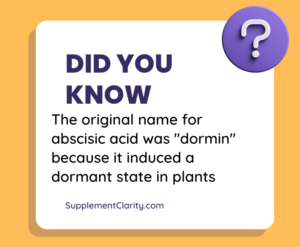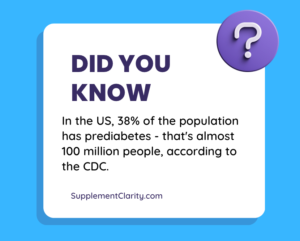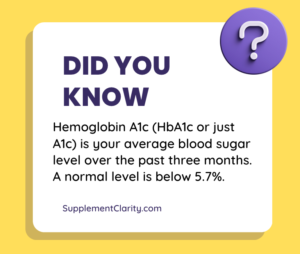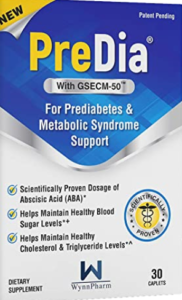As rates of diabetes and pre-diabetes continue to rise in first-world nations, the quest to find natural ways to lower blood sugar marches on. One possible solution may be abscisic acid, a hormone found in plants, foods, and animals. Abscisic acid (ABA) is a stress hormone that plants release under times of environmental strain. However, in people, this hormone appears to work as a regulator of glucose metabolism. This reporter feels you will soon start seeing advertisements for abscisic acid supplements. Discover the science of abscisic acid and what it means for you.
What is Abscisic Acid?
Abscisic acid (ABA) is a phytohormone – a plant hormone manufactured in the leaves during times of stress. The hormone was first isolated in 1963 and named “dormin” because it promoted plant dormancy and inhibited growth. However, other researchers soon discovered another substance that also  inhibited plant growth, which they named abscisin II. Later, dormin and abscisin II were revealed to be the same thing. Both substances were then renamed abscisic acid, as the hormone is known today. Abscisic acid is a member of the sesquiterpene family of compounds found in plants, fungi, and some insects. In plants, it acts as a defense hormone protecting the plant from environmental stressors like UV radiation, cold, water shortage, etc.
inhibited plant growth, which they named abscisin II. Later, dormin and abscisin II were revealed to be the same thing. Both substances were then renamed abscisic acid, as the hormone is known today. Abscisic acid is a member of the sesquiterpene family of compounds found in plants, fungi, and some insects. In plants, it acts as a defense hormone protecting the plant from environmental stressors like UV radiation, cold, water shortage, etc.
Pro-tip. Make sure to distinguish abscisic acid from ascorbic acid (vitamin C), as they differ from each other.
What Does Abscisic Acid Do In Plants & People?
The functions of abscisic acid vary between animals and plants. However, here is a summary of its effects:
- Activates in response to environmental stress, such as cold and drought.
- Lowers blood sugar levels in mammals.
- Stimulates insulin secretion in mammals.
- Inhibits plant growth until the environment is optimal for growing.
- Promotes storage of proteins, fats, and carbohydrates in seeds.
- Regulates genes that protect plants from water loss during extreme environments.
- Protects plant embryos from stressful environments by promoting dormancy.
- Halts stem cell differentiation in the primary root system of plants.
- Triggers closure of the stromata in plants.
- Promotes old age (senescence) of leaves and the detachment of those leaves from the plant.
Foods That Contain Abscisic Acid
Low levels of this nutraceutical substance are found in many commonly eaten foods. For example, on average, fruit contains 0.62 mg per kg of abscisic acid. In contrast, the average amount found in vegetables is about 0.29 mg per kg. As can be seen from the table below, Avocados and figs contain some of the highest amounts.
| Food | Amount mg per kg |
| Avocado | 2.00 |
| Figs | 0.72 |
| Citrus fruits | 1.25 |
| Soybeans | 0.79 |
| Corn | 0.33 |
| Black pepper | 0.25 |
| Bananas | 0.22 |
| Cucumbers | 0.09 |
| Tomatoes | 0.20 |
Apricots also have high amounts of ABA, containing 2583.4 picomols per gram. Furthermore, the Patent revealed that 8 oz (250 g) of apricots increase ABA in healthy people even greater than glucose.
Pay attention that the amounts are in mg per kilogram. A kilogram is 2.2 pounds. This means that 2.2 pounds of avocados yield about 2 mg of abscisic acid. Since most people don't eat large amounts of fruits and vegetables, this tells us there's not much abscisic acid in the amounts of food typically consumed by people eating a standard American diet.
For example, the average American who eats less than three servings of fruits and vegetables (combined) per day consumes only about 189 micrograms of abscisic acid. However, if that person increases their intake to 4.5 servings – the amount recommended by the American Heart Association – then it increases to about 297 micrograms per day. The clinical studies summarized below tend to use more than this.
Abscisic Acid For Diabetes & Insulin Resistance
Various studies point to abscisic acid as a possible natural diabetes/glucose support treatment. Here's what is known:
- Abscisic acid appears to lower blood sugar levels.
- Abscisic acid is released from pancreatic Beta cells, which also release insulin. In fact, ABA actually stimulates insulin release. Equally interesting is that fat cells also release abscisic acid in response to sugar consumption.
- People who have type II diabetes and gestational diabetes are reported to have lower levels of abscisic acid compared to healthier people.

- Studies also indicate that abscisic acid levels increase in the blood when people consume sugar.
In light of these facts, is there any proof this substance benefits people with prediabetes, insulin resistance, and type II diabetes? Yes. Much of the research has been conducted by the patent holders. Here's a summary of some of the evidence:
Human Study 1
In this investigation, researchers recruited 10 healthy people (the average age was 43) and gave them abscisic acid at a dosage of 1 microgram per kilogram of body weight daily for 75 days. In addition, the people also followed their usual way of eating, which was the Mediterranean eating style. The supplement used was called GSECM-50, which contains about 55 mcg of ABA per tablet. The study revealed that in 7 of the 10 people, fasting blood sugar, HbA1c, total cholesterol, and body mass index (BMI) were all less than at the start of the trial. More specifically:
- Fasting blood sugar decreased by 20.6%
- HbA1c declined by 5.7%
- Total cholesterol was 15.4% lower
- Body mass index fell by 3.1%
- Waist circumference decreased by 5.7%
- Heart disease risk declined by 17.2%
In addition, this investigation also demonstrated that a single dose of abscisic acid reduced blood sugar levels when people ate a high carbohydrate breakfast. Interestingly ABA appeared to work best in those who began the study with borderline high blood sugar, cholesterol, and BMI.
Drawbacks of the study
- No placebo group
- The people ate a healthy Mediterranean diet
Abscisic Acid Video Review
I posted the review on my Youtube channel with additional information so watch the video too.
Human Study 2
In this study, researchers gave 10 healthy people fig-extract drinks containing different amounts of abscisic acid. They then had them consume a sugary beverage to see what happened to their blood sugar levels. People consuming 200 mg and 1200 mg of fig extract (containing 80 micrograms of ABA) demonstrated 13% to 25% lower blood sugar and insulin levels two hours after consuming the high-sugar beverage. In this study, a supplement called ABALife was used.
Problems with the study
While this investigation revealed impressive results, there are some limitations, such as:
- Nobody had diabetes or prediabetes.
- All the people had a healthy body weight (i.e., nobody was overweight).
- The people ranged from 18 to 45 years of age. What does this mean for older folks?
- There was no placebo group.
- The study only had ten people.
Human Study 3
In another human clinical trial, which lasted three months, researchers recruited 60 overweight people with prediabetes. They randomly gave them abscisic acid or a placebo. While these people were diagnosed with higher than normal fasting glucose or impaired glucose tolerance, none took metformin or other diabetes medications. The people took either a placebo or 2 grams of an abscisic acid supplement three times a day in the following manner:
- one sachet before breakfast
- one sachet before lunch
- two sachets before dinner
Three months later, the people taking abscisic acid had:
- Significant reductions in fasting blood sugar.
- Significant decreases in post-prandial blood sugar.
- Significant reductions in insulin levels.
- Significant reductions in HbA1c levels.
- Significantly lower inflammation.
After three months of taking the ABA supplement, 27% of the people showed normal glycemic responses to sugar consumption, and only 20% still had impaired fasting glucose levels. None of the people taking the supplement progressed to type II diabetes, although about 7% of those taking the  placebo did. On the downside, abscisic acid did not appear to reduce body mass index, body weight, cholesterol, bad (LDL) cholesterol, or triglycerides.
placebo did. On the downside, abscisic acid did not appear to reduce body mass index, body weight, cholesterol, bad (LDL) cholesterol, or triglycerides.
How Does Abscisic Acid Lower Blood Sugar?
It has been speculated that ABA enhances the uptake of blood glucose by muscle cells. Animal research indicates that abscisic acid works by activating glucose sugar transporters called GLUT4 in muscle fibers. Typically, GLUT4 transporters respond to insulin; however, ABA appears to help them work better without requiring extra insulin. In addition, AMP-activated protein kinase (AMPK) in muscle cells appears to help ABA reduce blood sugar.
It is also speculated that ABA increases the production of brown adipose tissue (brown fat). Since brown fat burns more calories than typical white fat, this may explain the reduction in body mass index seen in some clinical trials.
Does Abscisic Acid Raise Insulin Levels?
Most studies show ABA helps regulate the release of insulin. However, this blood sugar-lowering effect is not accompanied by elevated insulin levels (hyperinsulinemia). This is good news because high insulin levels can contribute to weight gain and liver problems in those with diabetes. So, could ABA offer a kinder, gentler way of naturally removing excess sugar from the blood?
Where Can You Buy Abscisic Acid Supplements?

Abscisic acid is incorporated into a supplement called PreDia. The PreDia supplement includes a compound called GSECM-50, which contains a “scientifically proven dosage of abscisic acid.” GSECM-50 is derived from grape seed extract, magnesium, and chromium. In addition, the GSECM-50 blend incorporates a vegetable extract called “ABAMET” which contains 55 mcg of abscisic acid per serving. At least one clinical trial has revealed the GSECM-50 substance reduces fasting blood sugar, HbA1c, cholesterol, and body mass index after 75 days of use. Another proprietary substance is ABALife, a compound made by EuromedGroup.com, which is derived from figs.
Where is Abscisic Acid Produced in People?
The beta cells of the pancreas and fat cells are known to produce ABA.
Does It Work The Same Way In People Who Have Diabetes?
One study revealed that ABA concentrations in the blood increase in healthy people after consuming a sugar-containing beverage. However, this does not seem to occur in people with type II diabetes or in pregnant women who have gestational diabetes. This indicates blood sugar problems interfere with ABA metabolism. Interestingly, in women with gestational diabetes, ABA secretion returned to normal one month after giving birth. It has also been noted that bariatric weight loss surgery restores normal ABA levels within one month after the procedure.
Where Does Abscisic Acid Come From?
While small amounts exist in many foods, in most of the nutraceutical clinical trials summarized above extracted it from figs. The reason for this may be because there is a patented process for isolating ABA from dried figs.
Does It Help Diabetic Neuropathy?
Diabetic neuropathy is a type of nerve damage that can accompany diabetes, especially as it worsens. So far, no studies have specifically indicated ABA improves neuropathy. This is one of the shortcomings of the research. In theory, if it helped improve or reverse blood sugar irregularities, it might help this condition too. However, without direct proof, it's difficult to draw conclusions.
Does Abscisic Acid Help People Lose Weight?
While human studies show that ABA reduces fasting and postprandial blood sugar, insulin, inflammation, and HbA1c levels, weight loss needs more research. For example, one study showed no weight loss when people took ABA supplements for three months. However, in another investigation lasting 75 days, both body mass index and waist circumference declined. Those researchers, however, did not appear to measure changes in body weight.
Is Abscisic Acid safe For Humans?
The US Food and Drug Administration (FDA) has deemed ABA generally recognized as safe (GRAS). Furthermore, the US Environmental Protection Agency (EPA) has also recognized abscisic acid as safe for people to consume, causing no dietary risks. This makes sense since ABA is found in figs, apricots, tomatoes, and other foods that are eaten regularly.
Abscisic Acid Side Effects
Human studies do not report any negative adverse reactions. In the three-month human study summarized above, ABA did not raise liver enzymes or creatinine levels. Here are some suggestions to help you use supplements that contain abscisic acid safely and sensibly:
- Start by taking less than recommended for the first week.
- Speak with your doctor if you take diabetes medications like metformin, insulin, or sulfonylureas.
- If you have gestational diabetes, talk to your doctor and pharmacist.
- Stop taking abscisic acid at least two weeks before surgery, including dental surgery.
- Consider other supplements you take that have blood sugar-reducing effects, such as chromium, berberine, and Gymnema Sylvestre
Verdict: Is Abscisic Acid A Legit Blood Sugar Supplement?
For the moment, I remain cautiously optimistic that ABA holds promise for those dealing with problems associated with elevated blood sugar levels. The real test, however, would be to see if long-term use could reverse type II diabetes. At least three clinical trials have been conducted and taken as a whole, they appear to show this plant hormone-derived nutraceutical substance has merit. But remember, it will take at least three months of continued use to see declines in HbA1c levels.
Here is an ABA Supplement To Take a Look At

Leave a Reply